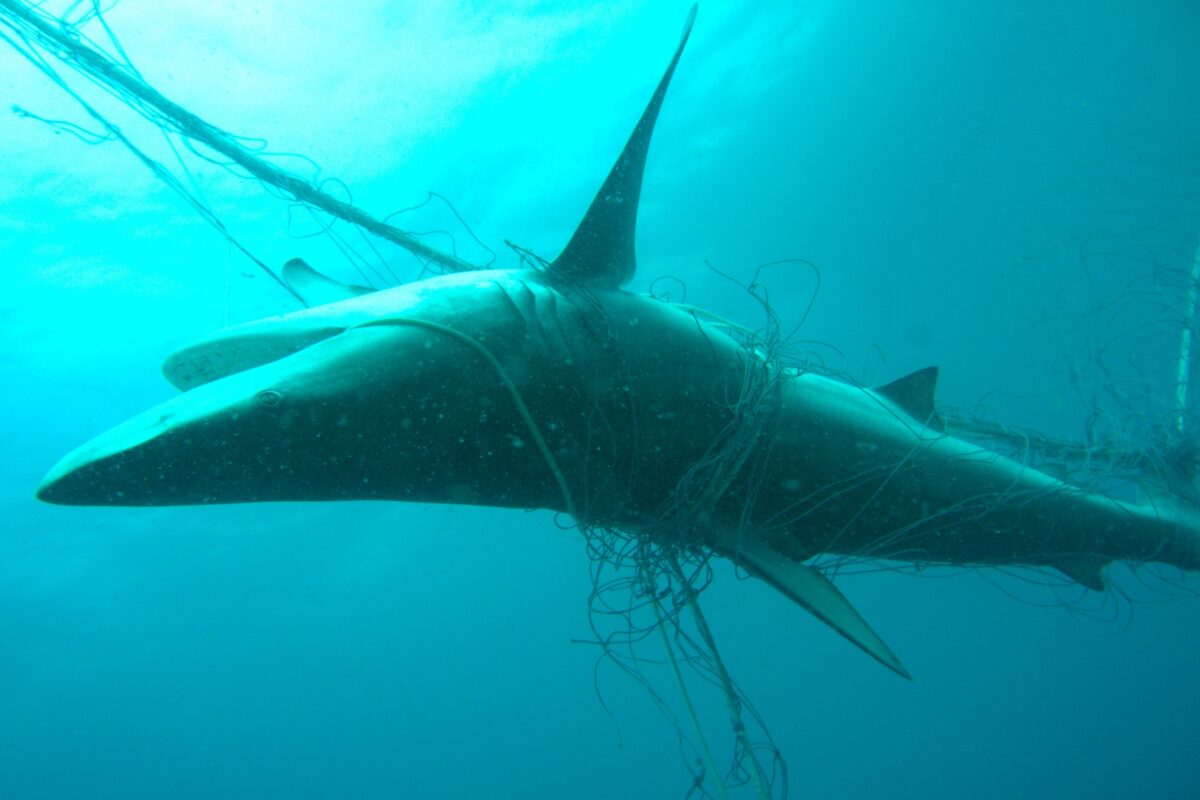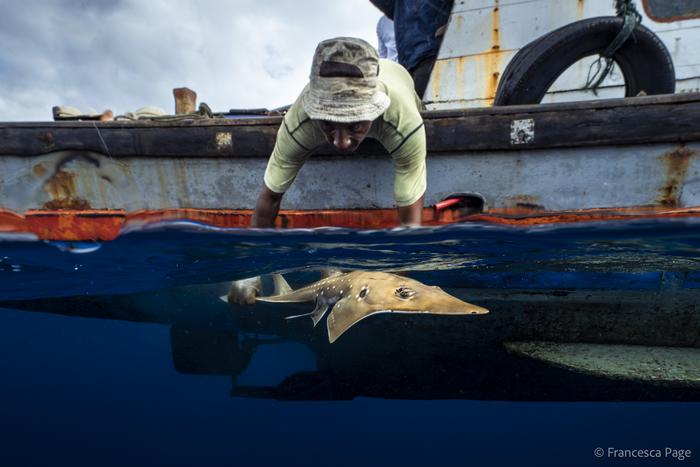- This month marks the 50th anniversary of the release of Jaws, a Hollywood blockbuster that depicts a series of attacks by a massive great white shark — a “man-eater” — in a fictional New England beach town.
- Shark populations have plummeted since the film was released, and experts agree that Jaws misrepresented the nature of sharks and likely had a net negative impact, however small, on their population sizes and conservation status.
- Most of the experts reached for this article said the film had spurred interest in sharks, some of which was channeled in positive directions. In fact, some people who worked on the film later advocated for shark conservation.
The movie Jaws, released on June 20, 1975, was one of the very first Hollywood summer blockbusters, and remains one of the highest-grossing films of all time, adjusted for inflation. Its dramatic tension comes from a series of attacks by a massive shark in a fictional New England beach town.
And yet, in the last 50 years, it’s the sharks that have been under attack: Sharks’ global abundance, along with closely related species, has declined by more than 70% since 1970, according to a 2021 study in the journal Nature. About one-third of sharks and closely related species are now threatened.
Experts have different views on how much of this decline can be attributed to a single film, but even skeptics of Jaws’ role agree that it misrepresented the nature of sharks and likely had a net negative impact, however small, on their population sizes and conservation status.
“It legitimized the killing of sharks, and … delegitimized any thoughts or concerns for the conservation of sharks,” Nick Dulvy, a professor of marine biodiversity at Simon Fraser University in Canada and a leading shark expert, told Mongabay.
Dulvy, a co-author of the 2021 study, said Jaws was “probably an enormous” factor in the decline in global shark populations of the last half-century.

Negative impacts
The film Jaws was based on a book of the same name published in 1974. Neither version explained the diversity of sharks. There are, in reality, several hundred shark species, ranging in size from the dwarf lanternshark (Etmopterus perryi), which is at most 20 centimeters (8 inches) long, to the whale shark, which can reach up to 18.8 m (62 ft) long.
Jaws portrayed a particular great white shark (Carcharodon carcharias) as a serial killer that developed a taste for human beings — a “man-eater.” The film led to increased fear of swimming, not just in the ocean but even in lakes and pools.
Phobias are rooted in emotional associations, not facts, according to Christopher Paul Jones, a phobia specialist in private practice in London, who’s worked with clients who have a fear of sharks. He told Mongabay that a mentor of his reported a sharp spike in shark phobias after Jaws was released.

“Jaws was incredibly effective in creating fear because of the way it tapped into psychological triggers,” Jones said, noting the use of the shark’s point of view, the dramatic music, and the portrayal of the shark as a “relentless predator.”
But that portrayal was completely unrealistic. Sharks kill very few people globally each year, and the idea that a “rogue” shark — as the fictional villain is called by the character Matt Hooper, a marine biologist played by actor Richard Dreyfuss — would target humans has no basis in science, Dulvy and other experts said.
“There’s no validity to it,” Chris Pepin-Neff, an associate professor in public policy at the University of Sydney in Australia, who’s researched the impact of Jaws for nearly two decades, told Mongabay.
Pepin-Neff, who says Jaws had a “huge effect” on shark populations, attributes the “rogue” shark theory to a Sydney-based surgeon named Victor Coppleson in the mid-20th century. Local policymakers in South Australia last year used it as a justification to push for a cull on sharks, though their bid was unsuccessful. (Shark policies on Australian beaches are a contentious issue.)
Jaws also led to an increase in recreational fishing for sharks, according to Greg Skomal, a shark biologist in the Massachusetts Division of Marine Fisheries, the same part of the U.S. where the movie was set. Skomal spent the 1980s and ’90s traveling to shark-hunting tournaments across New England to gather specimens of the animals, he told Mongabay.
However, Skomal said he’s skeptical that the film had a huge impact on shark populations. Government culling and recreational hunting for sharks existed, on a smaller scale, before Jaws, as did a pervasive fear of sharks, which the movie “tapped into,” Skomal said.
In any case, culling and recreational fishing have accounted for just a tiny fraction of global shark deaths. Far and away the largest reason for shark population declines, as Skomal and all of the other experts reached by Mongabay pointed out, is industrial fishing. The 2021 study in Nature attributes the huge decline in shark and ray populations to an 18-fold increase in fishing pressure since 1970. Roughly 100 million sharks are killed per year by commercial fishing vessels.

How much Jaws has had to do with commercial fishing-related deaths, if at all, is hard to determine, and expert opinions vary.
Paul Cox, CEO of the Shark Trust, a U.K.-based conservation NGO, told Mongabay in an email that the film perpetuated a “very narrow definition of what a shark is,” and lamented that “we still view the world of sharks through the lens of this movie.”
But he said the main problems for sharks were “driven by a combination of increasing global demand for shark products and inadequate fisheries management. For me, it’s not clear any of this can genuinely be attributed to the film.”
In the 1960s and ’70s, new industrial fishing techniques were developed that vastly increased the scale at which companies could extract marine life from the sea. In the decades that followed, a burgeoning Chinese middle class sought out more and more shark fin soup, a delicacy in the country.
While consumption of shark fins in China has gone down over the past 15 years or so, global demand for sharks has continued to rise. Some of this is due to demand for liver oil and shark skin, but the main increase in demand is for shark meat. Certain species like shortfin mako (Isurus oxyrinchus) have highly sought-after meat that’s very expensive. For many other species, the meat is used as a cheap protein option, as in southern Brazil, where it’s called cação and consumers often don’t know it’s shark meat.
In addition, much of industrial shark catch has historically been “bycatch” — that is, not an official target species of fishers — but increasingly fishing companies have turned to sharks because other commercial species have become harder to profit from due to declines in abundance and increased regulation.

Some governments, such as those of the United States, the European Union, South Africa and Australia, have taken notable steps to improve fisheries protections for sharks in their waters. Still, the global picture remains scary for the iconic sea creatures. Consequential debates over their protection are ongoing.
Dulvy said Jaws “demonized” sharks and “legitimized their continued killing” in a way that could have contributed to foot-dragging on pro-shark conservation policies by countries and international bodies. For many people, Jaws remains one of their only connections to sharks, and the fear of sharks makes protecting them seem unnecessary, Dulvy said.
“How do you protect a species that can hurt the public?” Pepin-Neff said, in reference to what they call the “predator policy paradox.”
Both Dulvy and Pepin-Neff agree that Jaws and other popular shark-related media, such as Shark Week, a sensationalist Discovery Channel television show that’s run since 1988, haven’t helped.
“You don’t have Shark Week if you don’t have Jaws,” Pepin-Neff said, pointing to a 1992 paper in the Journal of American Culture that drew connections between the two. Jaws also spawned three sequels and a number of other shark-horror related films, such as The Meg, Deep Blue Sea and even Sharknado — a film with a tornado of sharks.
The influence of the original Jaws on public perceptions of sharks remains strong, but work is being done to shift it, Pepin-Neff said. They and other experts, in seeking to counter the idea that sharks intend harm, have argued that the phrase “shark attack” has been misused. And certain governments and media outlets such as The New York Times have started to modify their language in recent years, Pepin-Neff said.

Silver linings
In 1995, Peter Benchley, who wrote the book Jaws and co-wrote the movie script, argued that “the shark in an updated Jaws could not be the villain; it would have to be written as the victim, for, worldwide, sharks are much more the oppressed than the oppressors.” Benchley worked on shark conservation efforts until his death in 2006. Many others involved with the movie also worked on shark conservation. These included cinematographer Valerie Taylor, who advocated on behalf of the gray nurse shark (Carcharias taurus) in the early 1980s, helping it to become the first shark species to receive protected status in the world, and Leonard Compagno, a scientific consultant for the film, who campaigned for great white sharks to be protected in South Africa, leading to seminal national legislation in 1991 that was copied by other countries.
Director Steven Spielberg has himself expressed regret about the effect that the film has had on shark populations, saying, “That’s one of the things I still fear — not to get eaten by a shark, but that sharks are somehow mad at me.” (A production company Spielberg founded is releasing a documentary about the making of the film this year.)
Fans of the film have also reckoned with its impact. Ross Williams, director of The Daily Jaws, an online community dedicated to the film, said the film’s portrayal of sharks as “bloodthirsty predators” had dire consequences.
“Jaws is a masterpiece of filmmaking, but with that legacy comes responsibility,” Williams told Mongabay in an email. “Acknowledging the harm done is not about canceling the film — it’s about contextualizing it. We love Jaws for what it represents artistically and culturally, but we also use it as a platform to advocate for accurate, science-based understanding of sharks today. Part of loving something deeply is being willing to examine its flaws and use that understanding to drive positive change.

“The Daily Jaws community includes scientists, conservationists, divers and fans who have turned their initial fear or fascination into advocacy,” he added.
Most of the experts reached for this article said the film had spurred interest in sharks, some of which was channeled in positive directions. The film may have inspired some viewers to become marine scientists. One of the film’s heroes, after all, is a marine biologist, and it’s not immediately evident to all viewers that his science is suspect.
Or it wasn’t at the time. Public understanding of sharks is improving, and the “Jaws effect” is diminishing, Skomal said. He said there was, for example, public pressure not to run shark-hunting tournaments that were commonplace after Jaws.
“Now I can’t think of a single one from New Jersey to Maine,” Skomal said.

Banner image: A dusky whaler shark (Carcharhinus obscurus) entangled in Ballina, New South Wales, Australia in 2017. Image courtesy of Sea Shepherd Australia.
Endangered shark trophies dominate the online wildlife trade, study finds
Citations:
Pacoureau, N., Rigby, C. L., Kyne, P. M., Sherley, R. B., Winker, H., Carlson, J. K., … Dulvy, N. K. (2021). Half a century of global decline in oceanic sharks and rays. Nature, 589(7843), 567-571. doi:10.1038/s41586-020-03173-9
Papson, S. (1992). “Cross the fin line of terror”: Shark Week on the Discovery Channel. Journal of American Culture, 15(4), 67-81. doi:10.1111/j.1542-734x.1992.1504_67.x
Cantor, J. (2004). “I’ll never have a clown in my house” — Why movie horror lives on. Poetics Today, 25(2), 283-304. doi:10.1215/03335372-25-2-283
Feedback: Use this form to send a message to the author of this post. If you want to post a public comment, you can do that at the bottom of the page.



